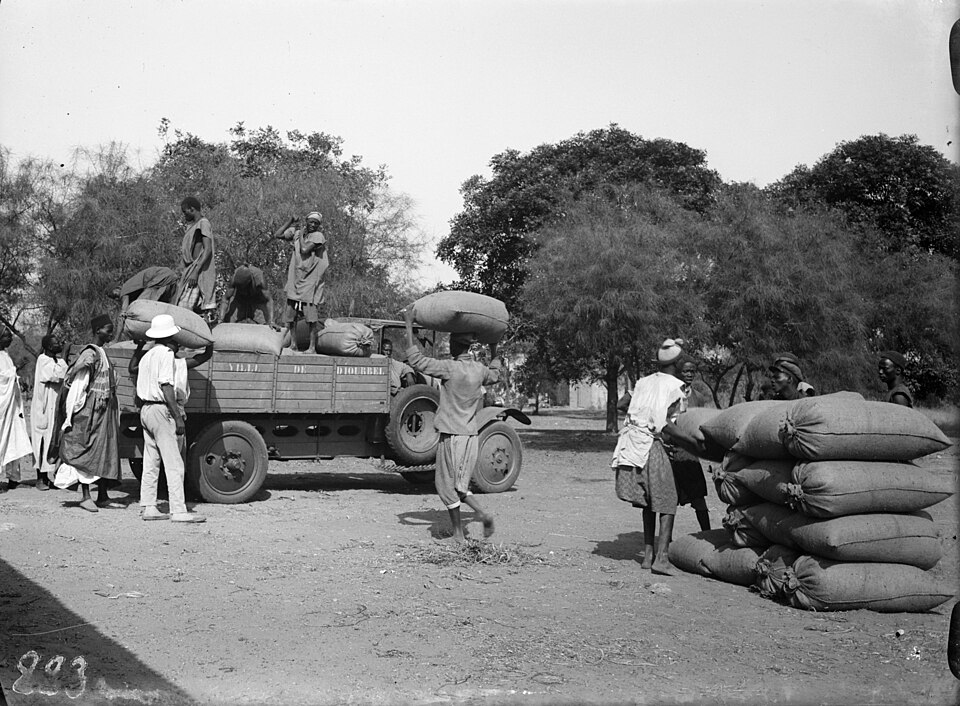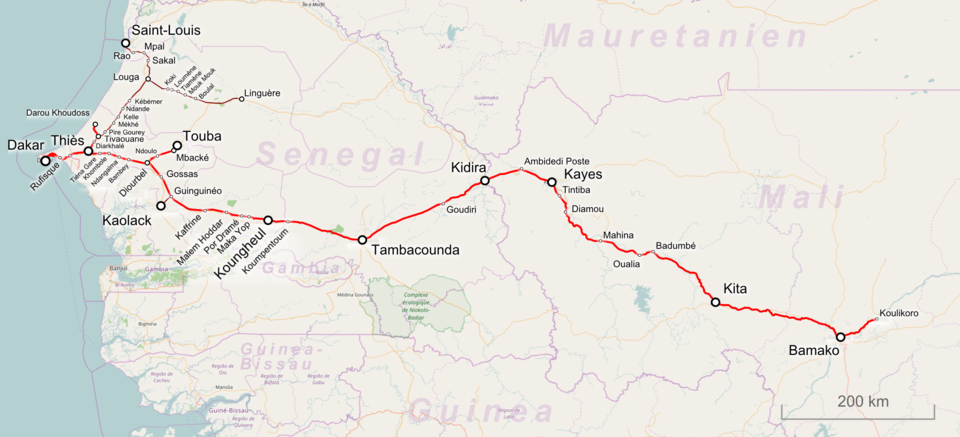IB Syllabus focus:
'Explore the colonial administration, economic, social, and political development in Senegal until its independence in 1960.'
Senegal's history as a French colony is pivotal to understanding its transition into a modern state. This period saw significant changes in Senegal's economic, social, and political landscapes, setting the stage for its emergence as an independent nation in 1960.
Economic Developments
Agricultural and Trade Policies
The French colonial strategy focused on integrating Senegal into the global market through cash crops, particularly peanuts, which became the cornerstone of Senegal's colonial economy. This approach was similar to the colonial administration of the Gold Coast, where cash crops also dominated the economy.

Taken in 1929 at Diourbel in Senegal’s peanut basin, this photograph shows sacks of groundnuts being delivered by truck for processing and export—evidence of the scale and organization of the colonial groundnut economy. The scene also hints at how labor and local transport systems were redirected toward cash-crop flows. Source
Cash crop monoculture made the local economy vulnerable to market fluctuations and placed pressure on food production sustainability.
Infrastructure
Investment in infrastructure such as railways, roads, and ports aimed to support the export-oriented economy, but often under-served local communities' needs.
The Dakar-Niger railway connected interior agricultural areas with the coastal capital, Dakar, which developed into West Africa's principal port. The development of infrastructure was crucial in many colonies, as seen in the strategic causes of partition in Africa.

This map traces the Dakar–Niger Railway from the Atlantic port of Dakar eastward into the interior, illustrating how colonial transport infrastructure moved cash crops—especially peanuts—from producing zones to port. The map extends beyond Senegal into present-day Mali to show the full corridor; this extra regional detail helps contextualize Senegal’s role within French West Africa. Source
Labour and Taxation
The introduction of forced labour (corvée labour) and head taxes coerced the Senegalese population into the colonial economy. Similar forced labour systems were used in other regions, notably during the Mandinka resistance to French rule.
Labour systems often disrupted family structures and local economies, leading to social and economic dislocation.
Fiscal Policies
France's investment in Senegal was driven by a mercantilist approach, focusing on benefiting the colonial power's economy at the expense of the colony's development.
Social Development
Education and Health
The colonial system established a French educational framework that catered primarily to a minority, creating an elite class detached from the wider population.
Health services improved, with the introduction of modern medical facilities, though they were unevenly distributed, favouring urban areas.
Cultural Impact
French culture permeated Senegalese society, with the French language becoming the medium of administration, education, and elite communication. The spread of French culture in Senegal can be compared to the spread of Islam and Christianity in Africa, which also had a profound impact on local societies.
The emergence of a bicultural elite led to social stratification based on access to French education and language.
Religion
Islam's deep-rooted presence led to a syncretic blend of Islamic and local traditions, despite French efforts to impose their culture. This blend of traditions was also seen in Ethiopian resistance under Menelik II, where local customs were maintained alongside resistance.
Colonial officials often co-opted religious leaders, attempting to maintain social control through these influential figures.
Political Developments
Early Administration
The Four Communes of Senegal held a unique status within French West Africa, with inhabitants granted rights as French citizens – a privilege not extended elsewhere in the federation.
Direct rule was exercised through a centralised administration from Dakar, marginalising traditional local governance.
Citizenship and Representation
The extension of French citizenship rights to African inhabitants of the Four Communes created a politically active urban class that engaged with the colonial system to advocate for African interests.
Post-WWII Changes
The Brazzaville Conference of 1944 initiated a series of reforms, leading to increased political representation and gradual decolonisation.
Senegal’s participation in French political processes expanded, especially after the 1946 Constitution, which provided the foundation for greater autonomy.
Towards Independence
The push for independence gained momentum with the rise of political parties and the weakening of the French Empire post-World War II. The dissolution of colonial rule mirrored the struggles seen in other regions, such as the Mandinka resistance to French rule.
The Mali Federation was a political experiment that illustrated the challenges of uniting diverse colonial territories with distinct colonial experiences.
Key Figures and Events
Léopold Sédar Senghor
As a central figure in both the cultural and political realms, Senghor's influence on Senegal's path to independence was profound.
His intellectual and political leadership, promoting the concept of négritude, sought to reclaim African identity from the colonial narrative.
The Break-Up of the Mali Federation
The Mali Federation dissolved due to internal political struggles and divergent visions for the future between Senegalese and Sudanese leaders.
Senegal's subsequent unilateral declaration of independence reflected a pragmatic approach to achieving sovereignty.
Legacy of Colonialism
Economic and Social Effects
The legacy of colonial economic structures can still be seen in Senegal's export-oriented economy and its reliance on foreign markets. The socio-economic divisions established during colonial times have persisted, as evidenced by the continued challenges faced by post-independence African nations.
Socio-economic divisions established during colonial times have persisted, with disparities in wealth, education, and power often tracing back to one's integration into the colonial system.
Cultural Identity
The Francophone heritage remains prominent, with French still used as the official language and as a lingua franca among the diverse ethnic groups within Senegal.
However, there has been a resurgence of pride in local languages and cultural practices as symbols of national identity.
Political Continuity and Change
The administrative and educational systems established by the French provided a framework that continued post-independence, albeit with significant adaptations to align with national priorities.
The French influence on Senegal’s development was multi-faceted, imprinting on it economic dependencies, social stratifications, and political structures that have had enduring impacts. The complex interplay between colonial legacies and indigenous practices shaped the trajectory of Senegal's quest for identity, sovereignty, and development. This period is not only a reflection of a nation under colonial rule but also a testament to the resilience and adaptive spirit of the Senegalese people.
FAQ
The Dakar-Niger Railway was instrumental in integrating Senegal's interior with its coastal capital, facilitating the export of peanuts and other commodities. Economically, it tied the colony's infrastructure to the demands of the French market, thereby reinforcing Senegal's role as a raw material source for France. Socially, the railway altered settlement patterns, with populations moving towards the rail line and the growing urban centres. It also resulted in the growth of a working class, including railway workers and related service industries, contributing to urbanisation and creating a new social dynamic distinct from the traditional rural structures.
The Tirailleurs Sénégalais (Senegalese Riflemen) were colonial infantry units recruited mainly from Senegal and other French colonies in West Africa. They played a significant role as part of the French Army, particularly during both World Wars. Their service was a potent instrument for France to showcase its colonial empire's reach and military might. However, the Riflemen’s experiences, especially during World War II, were instrumental in raising political awareness and expectations for better treatment and more rights, which later translated into increased nationalist sentiments and demands for independence in Senegal and other colonies.
World War II had a profound impact on the nationalist movement in Senegal. The participation of Senegalese soldiers in the war, alongside the exposure to ideas of liberty, equality, and fraternity, increased political consciousness among Senegalese soldiers and the general population. The war's end saw a global shift against colonialism, and the economic strain on France led to reforms such as the Brazzaville Conference, which promised greater political rights and representation. This political opening allowed leaders like Léopold Sédar Senghor to gain political ground. The war also weakened European powers, thereby creating a more conducive environment for decolonisation movements within Africa, including Senegal.
During the colonial period, peanuts became the main cash crop produced in Senegal. The production of peanuts was heavily encouraged by the French to supply their own market with vegetable oil. This focus on a single cash crop led to monoculture, which exposed the local economy to the volatility of international markets and the danger of soil depletion. Furthermore, the prioritisation of peanut farming for export resulted in reduced agricultural diversity and neglected food crops for local consumption, causing Senegal to import food and perpetuating economic dependency on France.
Senegal's status within French West Africa was distinct primarily due to the 'Four Communes' (Dakar, Saint-Louis, Gorée, and Rufisque), where inhabitants were granted the rights of French citizens as early as 1848, unlike other colonies. This unique status was a result of Senegal's longer history of French influence, starting from the 17th century, and its role as the French West African capital. This early and more profound French influence led to a higher degree of assimilation policies in Senegal. It facilitated the emergence of an African elite with access to French civil rights, education, and political life, which was not commonly found in other colonies.
Practice Questions
The French policy of assimilation profoundly impacted Senegal's social and political landscape. Socially, it created a bifurcated society, dividing the French-educated elite from the masses adhering to traditional customs. Politically, assimilation policies laid the groundwork for the emergence of a politically aware African class, which later played a pivotal role in the nationalist movements. These elites, through access to French education and political institutions, could effectively articulate Senegalese aspirations for independence, significantly contributing to the decolonisation process. Hence, assimilation was instrumental in fostering a political consciousness that was crucial to Senegal's eventual independence.
I strongly agree with the statement that the economic policies in colonial Senegal were designed to benefit the French metropole rather than the colony's development. The focus on cash crops like peanuts for export to France led to economic monoculture, making the colony vulnerable to market changes and neglecting food security for local populations. Infrastructure projects primarily served the interests of resource extraction and export to France, with little regard for the colony's overall economic development. Consequently, these policies entrenched economic dependency, stifling local enterprise and exacerbating inequalities that hindered Senegal's post-independence economic growth.

